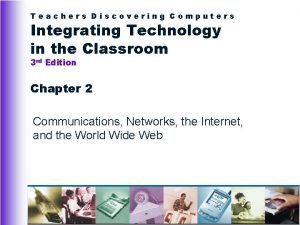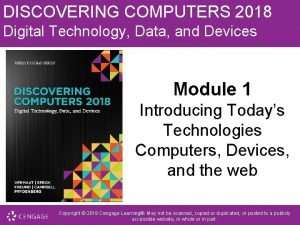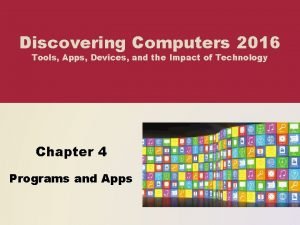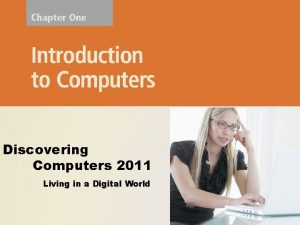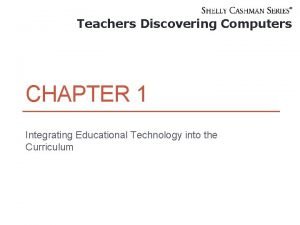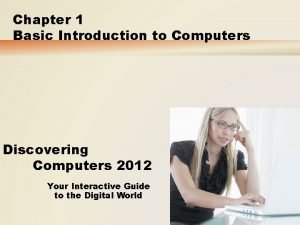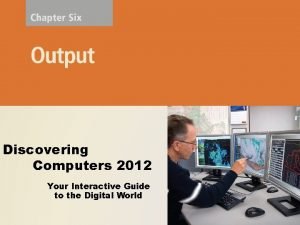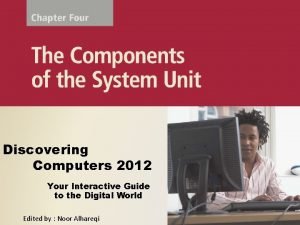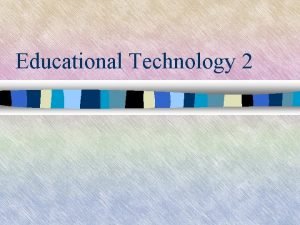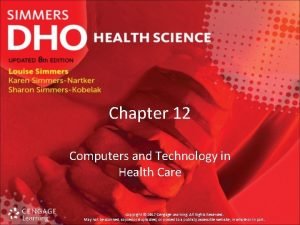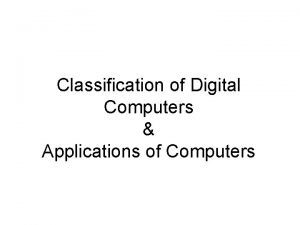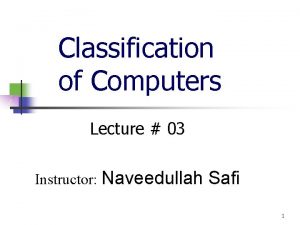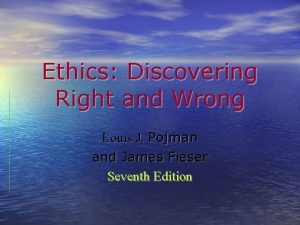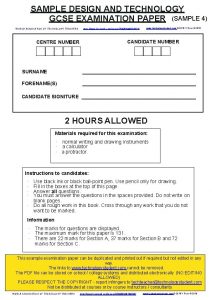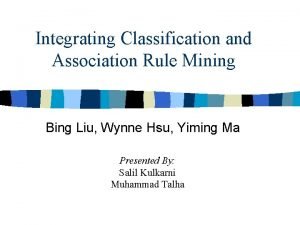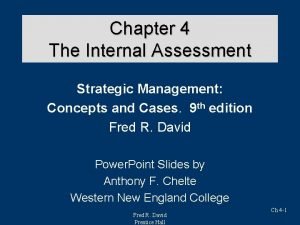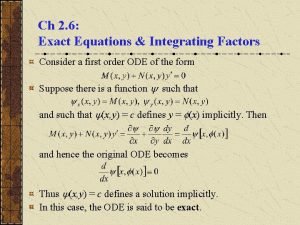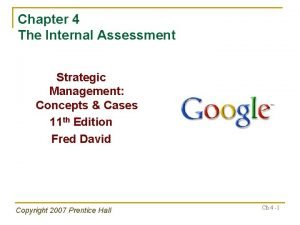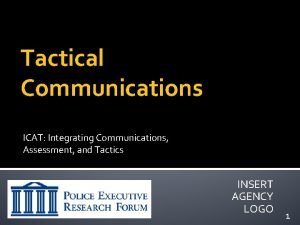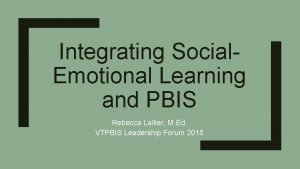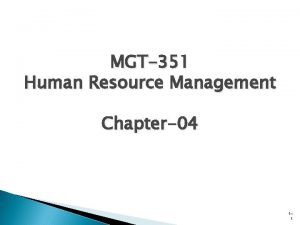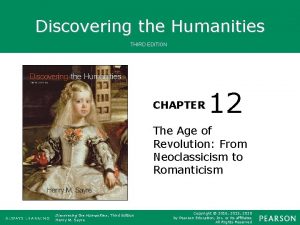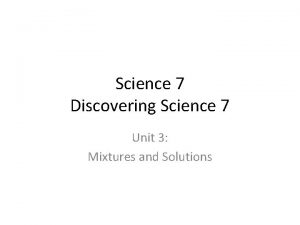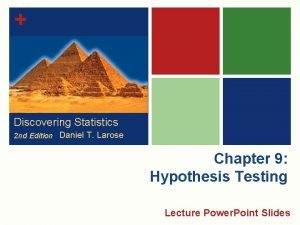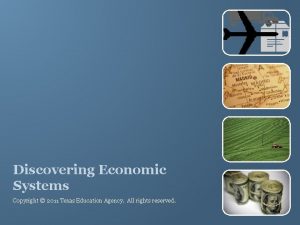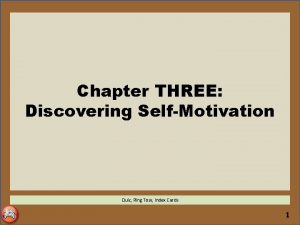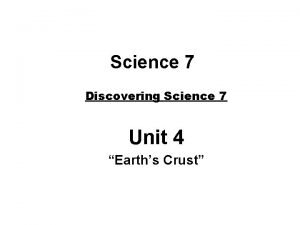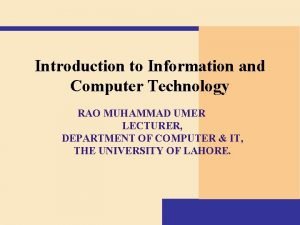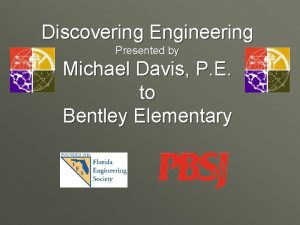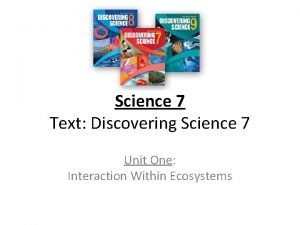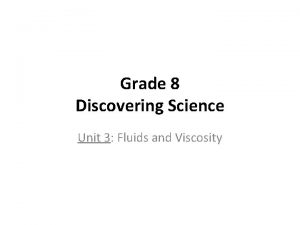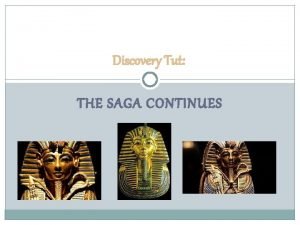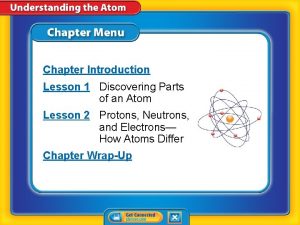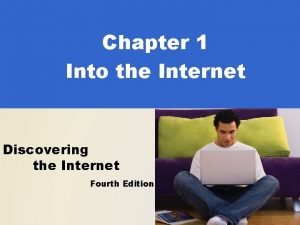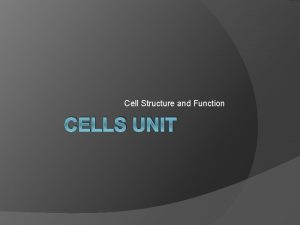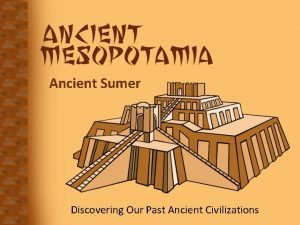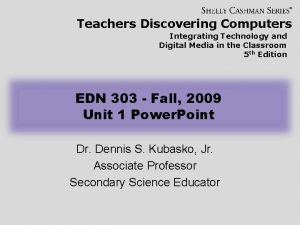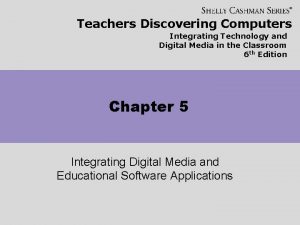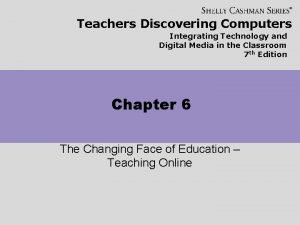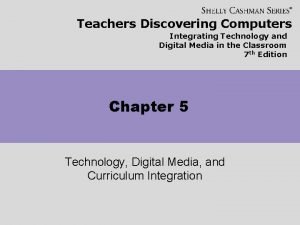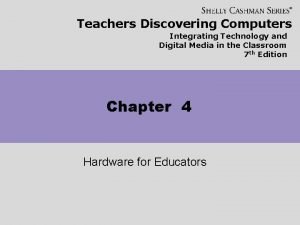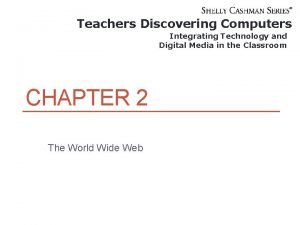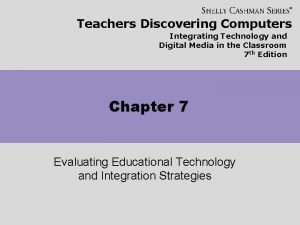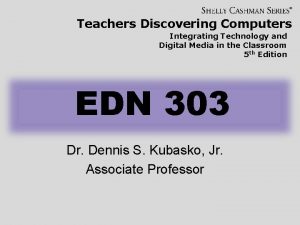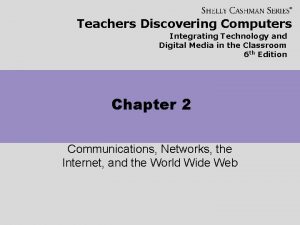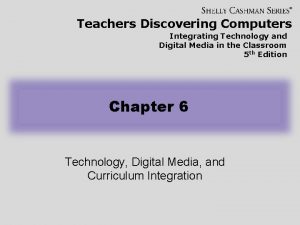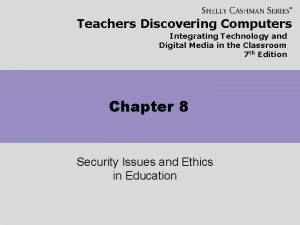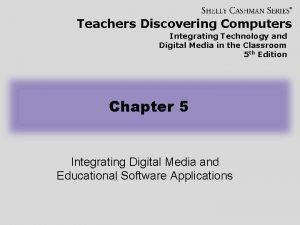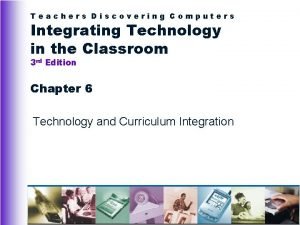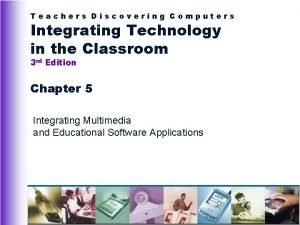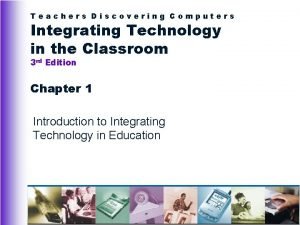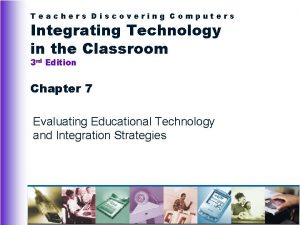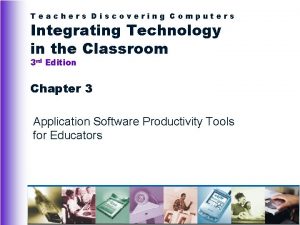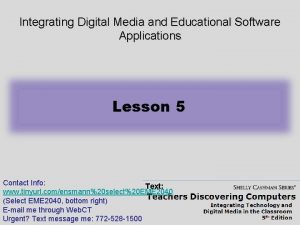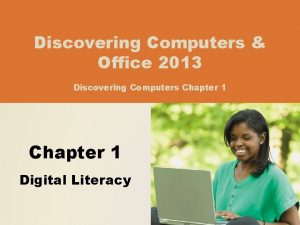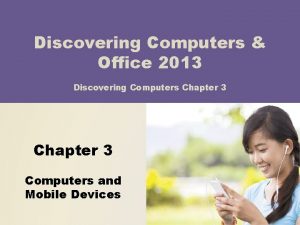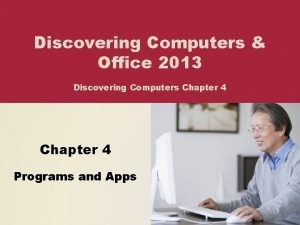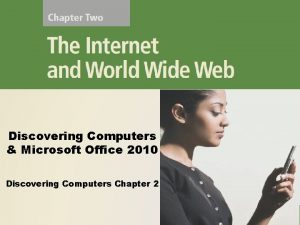Teachers Discovering Computers Integrating Technology and Digital Media













































- Slides: 45

Teachers Discovering Computers Integrating Technology and Digital Media in the Classroom 6 th Edition Chapter 1 Integrating Educational Technology into the Curriculum

Chapter Objectives § Define curriculum-specific learning § Explain the difference between computer, information, and integration literacy § Explain the necessity of changing instructional strategies from traditional to new learning environments § Describe the evolution of computers and digital media § Differentiate among the various categories of computers Chapter 1: Integrating Educational Technology into the Curriculum 2

Chapter Objectives § Explain why computer technology and digital media are important for education § Describe the National Educational Technology Standards for Teachers (NETS-T) and Students (NETS-S) § Explain why 21 st century skills need to be incorporated in K -12 curriculum § Describe the characteristics of today’s digital students § Describe six categories of what today’s students need to know § Provide examples of how computers are changing the way people teach and learn Chapter 1: Integrating Educational Technology into the Curriculum 3

Curriculum-Specific Learning § Learning how to apply teaching principles, knowledge, and ideas to authentic and practical classroom lessons and projects that can benefit your students Chapter 1: Integrating Educational Technology into the Curriculum 4

Computer, Information, and Integration Literacy § Computer literacy § Knowledge and understanding of computers and their uses § Information literacy § Knowing how to find, analyze, and communicate information § Integration literacy § The ability to use computers, digital media, and other technologies combined with a variety of teaching and learning strategies to enhance students’ learning Chapter 1: Integrating Educational Technology into the Curriculum 5

Computer, Information, and Integration Literacy Computer technology and digital media are present in every aspect of daily living — in the workplace, at home, in the classroom, and for entertainment Chapter 1: Integrating Educational Technology into the Curriculum 6

What Is a Computer and What Does It Do? § An electronic device, operating under the control of instructions stored in its memory, that can accept data, process the data according to specified rules, produce results, and store the results for future use § A computer is a computational device Chapter 1: Integrating Educational Technology into the Curriculum 7

What Is a Computer and What Does It Do? § § Data - collection of unorganized facts Information - data that is organized, meaningful, and useful Input - data entered into a computer Output - processed results from a computer Chapter 1: Integrating Educational Technology into the Curriculum 8

What Is a Computer and What Does It Do? § Storage – holding data and information for future use § Information processing cycle – the cycle of input, process, output, and storage § Hardware – the electronic and mechanical equipment that makes up the computer § Software – a series of instructions that tells the hardware how to perform tasks Chapter 1: Integrating Educational Technology into the Curriculum 9

The Evolution of Computers and Digital Media § The goal of multimedia computing and communications is to assist individuals in organizing and managing vast amounts of information in various types of media § Digital media – technologies that allow users to create new forms of interaction, expression, communication, and entertainment in a digital format Chapter 1: Integrating Educational Technology into the Curriculum 10

The Evolution of Computers and Digital Media Chapter 1: Integrating Educational Technology into the Curriculum 11

Categories of Computers § § Personal computers Mobile computers and mobile devices Game consoles Servers, supercomputers, and embedded computers Chapter 1: Integrating Educational Technology into the Curriculum 12

Personal Computers § A computer that performs all of its input, processing, output, and storage activities by itself Chapter 1: Integrating Educational Technology into the Curriculum 13

Mobile Computers and Mobile Devices § Mobile Computers § Notebook computer § Tablet PC § Netbook § Mobile Devices § Handheld Computer § PDA § Smartphones Chapter 1: Integrating Educational Technology into the Curriculum 14

Game Consoles § Mobile computing device designed for single player or multiplayer video games § Controller is the input device § Television is the output device § Hard Disks, CDs, DVDs, and memory cards are used for storage Chapter 1: Integrating Educational Technology into the Curriculum 15

Servers, Supercomputers, and Embedded Computers § Server § Manages the resources on a network and provides a centralized storage area for software programs and data § Supercomputer § Used for tasks such as analyzing weather patterns, tracking hurricanes, and identifying safety issues regarding the space shuttle § Embedded computer § A special-purpose computer that functions as one component in a larger product Chapter 1: Integrating Educational Technology into the Curriculum 16

Why Use Computer Technology in Education? § Technology and digital media are everywhere § Technology can support learning § Computers support communications beyond classroom walls § Support of national and international organizations Chapter 1: Integrating Educational Technology into the Curriculum 17

Why Use Computer Technology in Education? Chapter 1: Integrating Educational Technology into the Curriculum 18

The World Is Flat § Lightning-swift changes in technology and communications put people all over the globe in touch with each other as never before Chapter 1: Integrating Educational Technology into the Curriculum 19

21 st Century Skills Chapter 1: Integrating Educational Technology into the Curriculum 20

Computing in the Digital Age § Digital Students: Who are they and how do they learn? § Digital generations – students use different technologies to communicate and to access information from multiple resources § Digital students (digital kids) § Hypercommunicators § Multitaskers § Goal oriented Chapter 1: Integrating Educational Technology into the Curriculum 21

Computing in the Digital Age Chapter 1: Integrating Educational Technology into the Curriculum 22

Computing in the Digital Age § Digital Students: What they should know § Creativity and innovation Chapter 1: Integrating Educational Technology into the Curriculum 23

Computing in the Digital Age § Gamemaker is an example of a software program that allows students to create video games while fostering opportunities for creativity and innovation Chapter 1: Integrating Educational Technology into the Curriculum 24

Computing in the Digital Age § Digital Students: What they should know § Communications and collaboration Chapter 1: Integrating Educational Technology into the Curriculum 25

Computing in the Digital Age § Digital Students: What they should know § Research and Information Fluency § Information fluency is when a person has mastered the ability to analyze and evaluate information Chapter 1: Integrating Educational Technology into the Curriculum 26

Computing in the Digital Age § Digital Students: What they should know § Critical thinking, problem solving, & decision making Chapter 1: Integrating Educational Technology into the Curriculum 27

Computing in the Digital Age § Digital Students: What they should know § Digital Citizenship Chapter 1: Integrating Educational Technology into the Curriculum 28

Computing in the Digital Age § Digital Students: What they should know § Technology operations and concepts Chapter 1: Integrating Educational Technology into the Curriculum 29

Computing in the Digital Age § ARCS motivational model § Developed in 1983 and applicable to learning in the digital age § Attention § Relevance § Challenge/Confidence § Satisfaction/Success Chapter 1: Integrating Educational Technology into the Curriculum 30

Computing in the Digital Age Chapter 1: Integrating Educational Technology into the Curriculum 31

An Example of How One School Uses Computers § Ridgedale High School § All computers on a local area network § Three labs of 30 computers each § PCs and Macs § High-speed Internet connection in each classroom Chapter 1: Integrating Educational Technology into the Curriculum 32

An Example of How One School Uses Computers Chapter 1: Integrating Educational Technology into the Curriculum 33

An Example of How One School Uses Computers § Superintendent § Technology plan § Committee members can access the plan remotely Chapter 1: Integrating Educational Technology into the Curriculum 34

An Example of How One School Uses Computers § Principal § Sending several text and e-mail messages to teachers and staff § Research on digital storytelling Chapter 1: Integrating Educational Technology into the Curriculum 35

An Example of How One School Uses Computers § School secretary § Computerized telephone system § E-mail and voice mail § Teacher database § School inventory database § Desktop publishing Chapter 1: Integrating Educational Technology into the Curriculum 36

An Example of How One School Uses Computers § Technology coordinator § Installing and testing new software § Supporting systems § Problem solving Chapter 1: Integrating Educational Technology into the Curriculum 37

An Example of How One School Uses Computers § Teachers § Community digital storytelling § Transmedia story § Research assignments § Wireless mobile lab § Network stores student data Chapter 1: Integrating Educational Technology into the Curriculum 38

An Example of How One School Uses Computers § Media specialist § Maintains online catalog § Creates classroom activities § Runs media center § Assists with research projects Chapter 1: Integrating Educational Technology into the Curriculum 39

An Example of How One School Uses Computers § Students § Live broadcast of Ridgedale News Show § Talking, texting, and instant messaging about digital storytelling projects Chapter 1: Integrating Educational Technology into the Curriculum 40

An Example of How One School Uses Computers § Parent § Web site links parents and school § Keep track of events § School information Chapter 1: Integrating Educational Technology into the Curriculum 41

An Example of How One School Uses Computers § Community § Links school and community § Students teach senior citizens how to use a computer Chapter 1: Integrating Educational Technology into the Curriculum 42

Chapter Summary § Define curriculum-specific learning § Explain the difference between computer, information, and integration literacy § Explain the necessity of changing instructional strategies from traditional to new learning environments § Describe the evolution of computers and digital media § Differentiate among the various categories of computers Chapter 1: Integrating Educational Technology into the Curriculum 43

Chapter Summary § Explain why computer technology and digital media are important for education § Describe the National Educational Technology Standards for Teachers (NETS-T) and Students (NETS-S) § Explain why 21 st century skills need to be incorporated in K -12 curriculum § Describe the characteristics of today’s digital students § Describe six categories of what today’s students need to know § Provide examples of how computers are changing the way people teach and learn Chapter 1: Integrating Educational Technology into the Curriculum 44

Teachers Discovering Computers Integrating Technology and Digital Media in the Classroom 6 th Edition Chapter 1 Complete Integrating Educational Technology into the Curriculum
 Teachers discovering computers
Teachers discovering computers Discovering computers 2018 chapter 1 ppt
Discovering computers 2018 chapter 1 ppt Discovering computers 2016
Discovering computers 2016 Discovering computers 2011
Discovering computers 2011 Discovering computers 2018 chapter 1
Discovering computers 2018 chapter 1 Discovering computers 2018 chapter 1
Discovering computers 2018 chapter 1 Tactile output
Tactile output Discovering computers 2012
Discovering computers 2012 Basic concepts on integrating technology in instruction
Basic concepts on integrating technology in instruction Chapter 12 computer technology in health care
Chapter 12 computer technology in health care Kim kroll
Kim kroll Introduction to digital control
Introduction to digital control Classification of digital computers
Classification of digital computers Louay safi
Louay safi Ethics discovering right and wrong
Ethics discovering right and wrong Technology student
Technology student Integrating classification and association rule mining
Integrating classification and association rule mining Integrating strategy and culture in internal assessment
Integrating strategy and culture in internal assessment Exact equations and integrating factors
Exact equations and integrating factors Integrating science and social studies
Integrating science and social studies Strategic management ppt chapter 4
Strategic management ppt chapter 4 Integrating qualitative and quantitative methods
Integrating qualitative and quantitative methods Integrating communications assessment and tactics
Integrating communications assessment and tactics Integrating sel and pbis
Integrating sel and pbis Integrating public health and primary care
Integrating public health and primary care Job analysis in hrm
Job analysis in hrm Benjamin latrobe
Benjamin latrobe Self motivation
Self motivation Discovering science 7
Discovering science 7 P value in statistics
P value in statistics Discovering economic systems comparative worksheet answers
Discovering economic systems comparative worksheet answers Discovering self motivation
Discovering self motivation Rock vs mineral
Rock vs mineral Mohamed computer technology
Mohamed computer technology Discovering engineering
Discovering engineering Discovering american ideals in primary sources
Discovering american ideals in primary sources Discovering science 7
Discovering science 7 Example of fluid
Example of fluid A r williams author of discovering tut
A r williams author of discovering tut Discovering personal genius
Discovering personal genius Chapter 7 lesson 1 discovering parts of an atom answer key
Chapter 7 lesson 1 discovering parts of an atom answer key Discovering the internet
Discovering the internet Discovering cells
Discovering cells Discovering our past ancient civilizations
Discovering our past ancient civilizations Weaving quotes into your writing
Weaving quotes into your writing Integrating quotes mla
Integrating quotes mla
